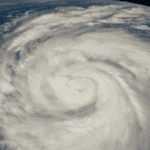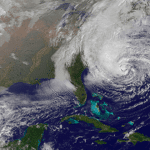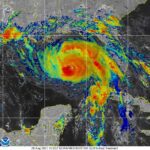Utilities along the U.S. Gulf Coast are preparing their response to Hurricane Laura as the massive storm bears down on the Texas and Louisiana coastlines.
Entergy Corp., whose territory includes those two states along with Arkansas and Mississippi, on August 26 said it had about 7,400 workers ready to respond to the storm, including 5,300 in Louisiana and 1,600 in Texas.
Laura as of late Wednesday was classified as a Category 4 storm, already bringing heavy rain to coastal areas ahead of the center of the storm. Residents were urged to evacuate coastal regions, areas that are expected to be inundated by a massive storm surge of nine feet or higher. Forecasters at the National Hurricane Center said water from that storm surge could move as much as 40 miles inland.

Laura’s maximum winds as of late Wednesday were 150 miles per hour, just 7 mph shy of being classified as a Category 5 storm. Laura is expected to weaken once it makes landfall, but strong winds of at least tropical storm force—anywhere from 40 mph to as high as 100 mph—are forecast for the next few days in areas well inland. The storm is eventually expected to impact the Midwest and mid-Atlantic states with heavy rain and strong winds.
“In my five years as governor, I don’t think I’ve ever had a press conference where I’m trying to convey the sense of urgency I’m trying to convey right now,” Louisiana Gov. John Bel Edwards said Wednesday as he urged residents to move to safer areas away from the coast.
“Unsurvivable storm surge with large and destructive waves will cause catastrophic damage from Sea Rim State Park, Texas, to Intracoastal City, Louisiana,” the National Weather Service (NWS) warned. Ben Schott, a meteorologist for the NWS, said, “Unsurvivable is not a word that we like to use. It’s one I’ve never used before.”
Widespread Power Outages
Power companies that serve the region expect widespread power outages due to the extremely strong winds and heavy rain associated with the storm. Some experts have said some of the hardest-hit areas could be without electricity for weeks.
CenterPoint Energy, which serves 2.5 million people in the Greater Houston area, on Wednesday warned some users could be without power for days after Hurricane Laura moves through the area, saying wind speeds will play a key role in the range and duration of outages.
Weather experts have characterized Laura as “extremely dangerous.” Entergy said it has moved equipment and crews from the path of the storm, to enable a faster response to begin restoring power as soon as possible after the storm passes.
“While we were fortunate that Marco had limited impact on our systems, customers should keep their guard up as Hurricane Laura, which is predicted to be much stronger, is on the way,” Eli Viamontes, vice president of Entergy utility distribution operations, said in a statement. Marco dissipated just south of the same area of the Gulf Coast on Monday, as that storm encountered wind shear that took it apart.
Laura, though, encountered much more favorable conditions for strengthening as it moved through the Gulf of Mexico. “Please remain storm-ready and take this as seriously as we are. This is expected to be a major hurricane and should be treated as such,” Viamontes said.
Alexis Kwasinski, associate professor of electrical and computer engineering at the University of Pittsburgh Swanson School of Engineering in Pennsylvania, regularly researches the impact of storms on electricity systems, looking at grid design and utility practices. He compared the potential impacts of Laura to those of Hurricane Rita, which hit the Gulf Coast in 2005 a few weeks after Hurricane Katrina devastated New Orleans and other parts of the region.
“Rita caused about 1.5 million outages lasting up to two weeks,” Kwasinski told POWER on Wednesday. “At least, it seems that the most severely affected area [from Laura] will be mostly bayous with very few towns and with the larger towns several miles inland. In any case, the most significant concern when there are back-to-back storms is weakened infrastructure and trees for the second storm due to water saturated soils and the winds from the first storm. My wild estimation is that Laura will still be similar to Rita.”
Gregg Edeson, utility reliability and resiliency lead at PA Consulting, where he studies management of power grids, told POWER that Gulf Coast utilities “know the drill and how to prepare” for major storms. “They will ensure that mutual aid resources are planned for, asset damage predictions are developed based on the projected path of hurricane, and materials and resources are staged accordingly,” Edeson said.
“Utilities are constantly learning and evolving based on previous events/storm surges/water intrusion issues,” Edeson said. “It is probably the case that mid-Atlantic utilities have shared lessons learned from recent experiences regarding logistics, PPE needs, crew isolation processes, testing of crews, etc.,” he added referencing the recent storm-related power issues related to Hurricane Isaias, which left areas of the mid-Atlantic and Northeast near the Atlantic Coast without power for several days.
Edeson also said utilities are faced with the challenge of power restoration efforts during the COVID-19 pandemic. “New items in our current environment to consider certainly include COVID safety precautions and processes to follow with internal and external resources being involved,” he said. “And as such these new safety precautions will end up taking time away from restoration as it was in the past.”
Utilities Prepare Storm Response
Laura Landreaux, president and CEO of Entergy Arkansas, said Wednesday the utility was “using these final hours ahead of the storm to patrol our system for service risks and ensure we have the necessary resources, equipment, and workforce to restore power as safely and quickly as possible. We understand the hardships an extended power outage can cause for our customers, especially during the heat of an Arkansas summer with so many working from home and remote learning for children. We understand, and we are making sure we are well prepared to respond. Our team will be hard at work to repair storm damage and bring customers the best information we have as quickly as possible.”
Florida Power & Light Co. said it has made several hundred employees and contractors available to help Entergy Louisiana and Entergy Texas with their power restoration efforts. “Our thoughts and prayers go out to our Gulf Coast neighbors as they prepare for the damage and destruction that will likely follow being hit by a tropical storm and then a hurricane in the same week,” Eric Silagy, FPL president and CEO, said in a statement. “Earlier this month, 600 FPL lineworkers and contractors helped restore power to our fellow citizens in New Jersey in the aftermath of Hurricane Isaias. As the tropics continue to produce storms that affect other areas of the country, we stand at the ready to assist our fellow Americans. These storms are a reminder that we must not let our guard down as we reach the peak of what is forecast to be a very active hurricane season.”
“In the state of Florida, Aug. 26 is recognized as Lineworker Appreciation Day—a time to recognize the vital work our men and women do every day,” said Manny Miranda, FPL senior vice president for power delivery in a statement. “Severe weather events provide an opportunity for our lineworkers to show their commitment to safety, to their profession and to those who seek their help. Our team is ready to face the challenges posed in the aftermath of these storms and the pandemic, taking extra measures to ensure their and the public’s safety.”
Tampa Electric, another Florida utility, said it has sent a crew of about 110 line workers, contractors, and support personnel to the New Orleans area to help Entergy Louisiana restore power following the storm.
Southwestern Electric Power Co. (SWEPCO), which serves Northeast Texas and Northwest Louisiana, said it has prepared more than 1,000 line and tree personnel to assist its company crews in responding to power outages. “Restoring power after the hurricane passes could take multiple days,” Drew Seidel, SWEPCO vice president of Distribution Region Operations, said in a statement. “We will make every effort to get the lights back on as soon as possible, and we want our customers to be prepared.”
The Midcontinent Independent System Operator (MISO), which manages the power grid in much of the central part of the U.S., on Wednesday said the agency “is closely monitoring developments related to Hurricane Laura and has proactively activated the Hurricane Management Command (HMC) structure. MISO is analyzing information from federal, state and local government agencies and taking extensive measures to ensure grid safety and reliability.”
“MISO has taken the necessary actions in coordination with our members to prepare for Hurricane Laura,” said Renuka Chatterjee, MISO’s executive director—system operations. “Our teams are working closely to maintain reliability as the storm makes landfall impacting generation and transmission facilities in its path and moves throughout our footprint.”
“Our top priorities are the health and safety of MISO employees, contractors and stakeholders and to ensure the grid and operating systems are secure and protected,” said Daryl Brown, executive director for MISO’s South Region. “We are working closely with our members to provide support during the storm and throughout recovery.”
—Darrell Proctor is associate editor for POWER (@DarrellProctor1, @POWERmagazine).










